A) calcite
B) gypsum
C) quartz
D) hematite
E) clay minerals
G) A) and B)
Correct Answer

verified
Correct Answer
verified
Multiple Choice
What type of cleavage would be exhibited by a mineral that has this arrangement of silicon tetrahedron? 
A) one direction of cleavage
B) two perpendicular directions of cleavage
C) two nonperpendicular directions of cleavage
D) the mineral factures instead of cleaves
F) A) and C)
Correct Answer

verified
Correct Answer
verified
Multiple Choice
Minerals that do not contain silicon are classified as:
A) nonsilicates
B) silicates
C) clays
D) mafic
F) None of the above
Correct Answer

verified
Correct Answer
verified
Multiple Choice
The very common mineral shown in this photograph is light colored, transparent, has a hardness of seven, and fractures rather than cleaves. It does not effervesce. What mineral is it? 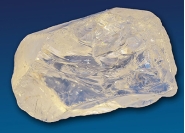
A) garnet
B) quartz
C) biotite
D) muscovite
E) feldspar
G) B) and D)
Correct Answer

verified
Correct Answer
verified
Multiple Choice
What type of silicate minerals is shown from this arrangement of silicon tetrahedron? 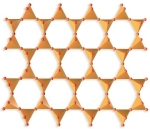
A) independent tetrahedra
B) single chains
C) double chains
D) sheets
E) frameworks
G) B) and E)
Correct Answer

verified
Correct Answer
verified
Multiple Choice
The mineral halite has cube-shaped crystals because:
A) there are no planes along which the mineral can break
B) cubes are the most common way two tetrahedron can join
C) of the arrangement of atoms in the crystal lattice
D) halite is soluble in water
F) A) and B)
Correct Answer

verified
Correct Answer
verified
Multiple Choice
Based on the different crystalline structure of these two carbon minerals, how would the two minerals likely differ? 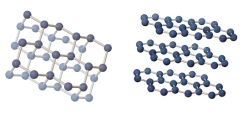
A) The left mineral would have one direction of cleavage.
B) The right mineral would have one direction of cleavage.
C) The minerals would have the same type of cleavage since both contain only carbon.
D) The minerals would have the same hardness because both contain only carbon.
F) A) and B)
Correct Answer

verified
Correct Answer
verified
Multiple Choice
From the list provided below, choose those observations that accurately describe the mineral presented in these images. Both images show the same type of mineral. 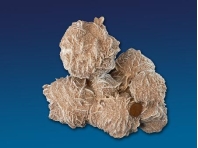
A) This mineral has a metallic luster.
B) This mineral is opaque, meaning that it is not clear; light does not pass through it.
C) This mineral has cleavage.
D) None of these.
F) B) and C)
Correct Answer

verified
Correct Answer
verified
Multiple Choice
Which layer in the earth has a composition similar to the granite shown in this photograph? 
A) continental crust
B) oceanic crust
C) mantle
D) core
F) A) and D)
Correct Answer

verified
Correct Answer
verified
Multiple Choice
Which side of this molecule has a negative charge? 
A) 1
B) 2
C) 3
D) all of these
E) none of these
G) D) and E)
Correct Answer

verified
Correct Answer
verified
Multiple Choice
What class of mineral forms when the elements Cl or F is bonded with a metal, as in the mineral halite? 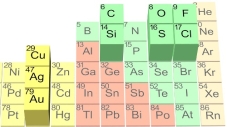
A) silicates
B) carbonates
C) oxides
D) halides
E) sulfides
G) A) and C)
Correct Answer

verified
Correct Answer
verified
Multiple Choice
What is a diagnostic characteristic of a mineral used to make a cement slab in your house?
A) it is magnetic
B) it has a hardness of 7
C) it has a hardness of 1
D) it has one main direction of cleavage
E) it reacts with dilute hydrochloric acid
G) A) and D)
Correct Answer

verified
Correct Answer
verified
Multiple Choice
What make it difficult to represent the model of an atom?
A) Atoms are much larger than their nuclei.
B) Electrons are too small to be shown to scale.
C) Electrons are constantly in motion and do not truly follow orbital paths.
D) Atoms are not hard spheres with well-defined edges.
E) All of these.
G) B) and C)
Correct Answer

verified
Correct Answer
verified
Multiple Choice
In which of the following types of bonding do atoms loan one or more electrons, as shown in this figure? 
A) covalent
B) ionic
C) metallic
D) intermolecular
F) None of the above
Correct Answer

verified
Correct Answer
verified
Multiple Choice
Which of the following is true about asbestos?
A) There are several types of asbestos, but they represent the same mineral.
B) Different types of asbestos have the same health risks.
C) Each type of asbestos has long, straight fibers.
D) Asbestos represents different minerals with different health risks.
F) B) and C)
Correct Answer

verified
Correct Answer
verified
Multiple Choice
A crystal with a well-defined shape, such as a cube, probably:
A) does not reflect the arrangement of atoms in the lattice
B) grew early and so was forced to grow around other minerals
C) does not have a well-defined cleavage
D) will react with dilute hydrochloric acid
E) none of these
G) A) and E)
Correct Answer

verified
Correct Answer
verified
Multiple Choice
What mineral test is shown in this photograph? 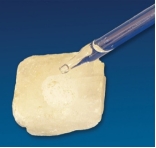
A) scratch test
B) effervescence
C) streak
D) magnetism
E) specific gravity
G) B) and C)
Correct Answer

verified
Correct Answer
verified
Multiple Choice
Which layer in the earth has a composition similar to the meteorite shown in this photograph? 
A) continental crust
B) oceanic crust
C) mantle
D) core
F) A) and B)
Correct Answer

verified
Correct Answer
verified
Multiple Choice
What mineral is characterized by a reddish streak, as shown in this photograph? 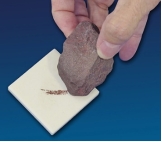
A) quartz
B) feldspar
C) calcite
D) hematite
E) magnetite
G) C) and D)
Correct Answer

verified
Correct Answer
verified
Multiple Choice
Which of the following largely determines an atom's atomic weight?
A) the number of neutrons
B) the number of electrons
C) the number of electrons in the outer shell
D) the number of protons and neutrons
F) A) and B)
Correct Answer

verified
Correct Answer
verified
Showing 61 - 80 of 131
Related Exams